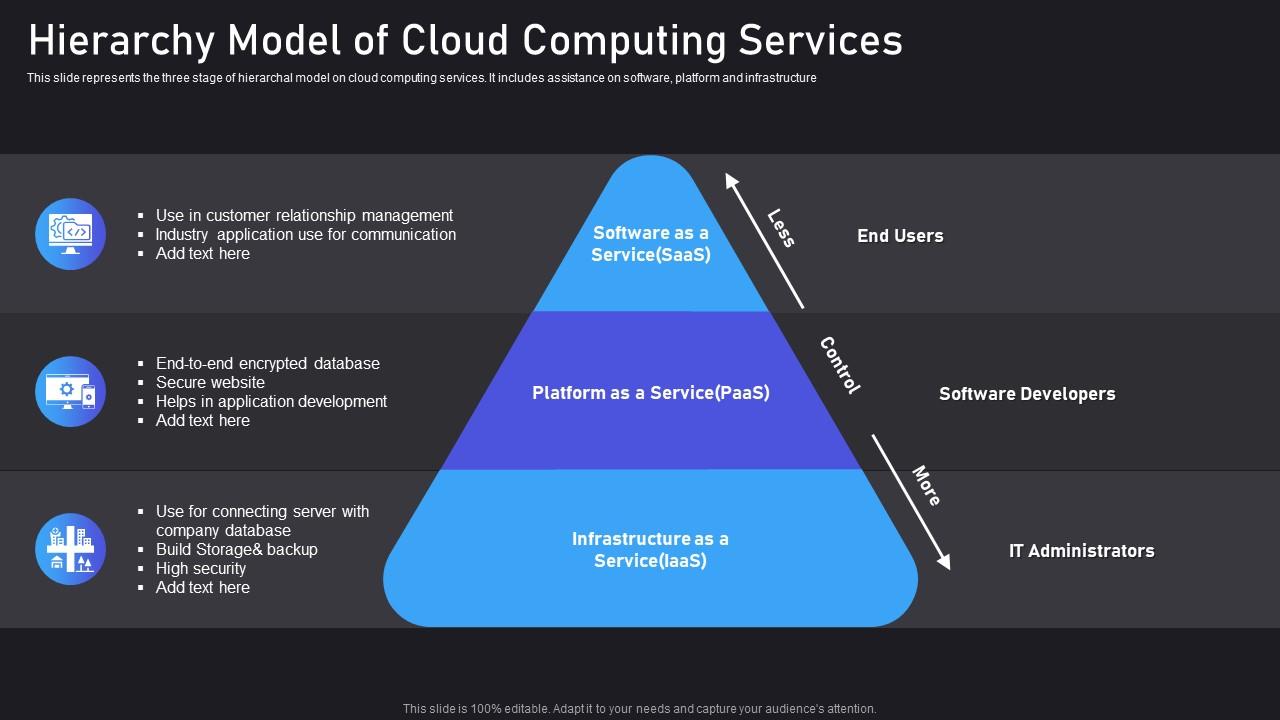
Cloud computing is the on-demand delivery of IT resources over the
Internet with pay-as-you-go pricing. Instead of buying, owning, and
maintaining physical data centers and servers, you can access technology
services, such as computing power, storage, and databases, on an
as-needed basis from a cloud provider like Amazon Web Services (AWS),Microsoft Azure,etc.
Hierarchy of Cloud Computing Services

Hierarchy of Cloud Computing Services refers to the wide variety of cloud computing services .The three main types of cloud computing include
Infrastructure as a Service, Platform as a Service, and Software as a
Service. Each type of cloud computing provides different levels of
control, flexibility, and management so that you can select the right
set of services for your needs.
1.Infrastructure as a Service- IaaS contains the basic building blocks for cloud IT. It
typically provides access to networking features, computers (virtual or
on dedicated hardware), and data storage space. IaaS gives you the
highest level of flexibility and management control over your IT
resources. It is most similar to the existing IT resources with which
many IT departments and developers are familiar.
2.Platform as a Service-PaaS removes the need for you to manage underlying
infrastructure (usually hardware and operating systems), and allows you
to focus on the deployment and management of your applications. This
helps you be more efficient as you don’t need to worry about resource
procurement, capacity planning, software maintenance, patching, or any
of the other undifferentiated heavy lifting involved in running your
application.
3.Software as a Service-SaaS provides you with a complete product that is run and
managed by the service provider. In most cases, people referring to
SaaS are referring to end-user applications (such as web-based email).
With a SaaS offering, you don’t have to think about how the service is
maintained or how the underlying infrastructure is managed. You only
need to think about how you will use that particular software.
Benefits of Cloud Computing
1.Agility- The cloud gives you easy access to a broad range of
technologies so that you can innovate faster and build nearly anything
that you can imagine. You can quickly spin up resources as you need
them–from infrastructure services, such as compute, storage, and
databases, to Internet of Things, machine learning, data lakes and
analytics, and much more.
2.Cost Saving- The cloud allows you to trade fixed expenses (such as data
centers and physical servers) for variable expenses, and only pay for
IT as you consume it. Plus, the variable expenses are much lower than
what you would pay to do it yourself because of the economies of scale.
3.Globally Expanded-With the cloud, you can expand to new geographic regions and deploy
globally in minutes. For example, AWS has infrastructure all over the
world, so you can deploy your application in multiple physical locations
with just a few clicks. Putting applications in closer proximity to end
users reduces latency and improves their experience.
Major Usecases of Cloud Computing
1.Netflix

Netflix is the world’s leading internet television network, with more
than 200 million members in more than 190 countries enjoying 125 million
hours of TV shows and movies each day. Netflix uses AWS(cloud computing service) for nearly all
its computing and storage needs, including databases, analytics,
recommendation engines, video transcoding, and more—hundreds of
functions that in total use more than 100,000 server instances on AWS.
2.Volkswagen

Volkswagen Group manufactures ten of the world’s most iconic automotive
brands including Audi, Lamborghini, and Porsche. With the goal of
becoming the world’s leading software-driven automotive company, the
Group is embracing a cloud-first mentality and revolutionizing its
global operations by building the Volkswagen Industrial Cloud on AWS.
3.McDonald's

McDonald’s is the world’s largest fast-food company that serves around 64 million people per day. The growth of this company has gone to another level when it started home deliveries. By utilizing AWS services, McDonald’s created a platform that integrates local restaurants with delivery partners such as Uber Eats. Scalability is also a reason for the company to choose AWS services. The cloud-native
microservices architecture allows the platform to scale to 20,000 orders
per second with less than 100-millisecond latency, and open APIs allow McDonald's to easily integrate with multiple global delivery partners.
4.Instagram
Picture-based
social media service Instagram has been run entirely on AWS since its
inception in 2010. It ran on cloud computing service Amazon EC2, which enabled it to build and run its own software without needing its own
servers.Instagram run its infrastructure on Amazon Web Services, running instances on their Elastic Compute Cloud (EC2).
4.NASA
NASA (National Aeronautics and Space Administration) has always wondered about creating a library to present people with all its achievements through pictures and videos of space. Later on, it created such platforms, but because it had 10 different NASA centers, it couldn’t provide the best experience for viewers. So, all it wanted was to create an easy-access platform for people to search for and view images and videos. Then, NASA started adopting many services from AWS to solve this problem, which included Amazon Elastic Compute Cloud, Elastic Load Balancing, Amazon Simple Storage Service, Amazon Simple Queue Service, etc. Among these, Amazon S3 helped the company store all the incoming data such as photos, videos, and audio files without any hassle.







Comments
Post a Comment